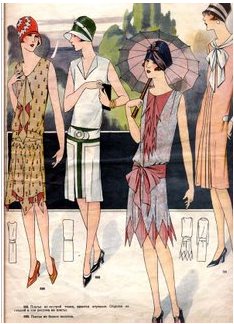Stuck On The Roaring '20s
- Brittany Kessler
- Nov 13, 2017
- 5 min read

(There are some adult themes, like sex, smoking, and drinking in this article. They're only mentioned in passing, though. If you're not about that, don't read.)
If I had to choose one era in American history to live in, it'd be -- without a doubt-- the 1920s.
You might think I'm out of my mind, a little spifflicated (drunk as hell) if you will, and you'd be right. To a point.
Yeah, there's the 1929 stock market crash on Black Monday. Yeah, there was Al Capone (but he was cool in an evil gangster kinda way. ) And yeah, there was the resurgence of the KKK, which was (and still is) awful and very very not good. At all.
However....
I do like having a toaster and a washing machine. And a safer and more stable economy. Also, voting is really nice.
This little infatuation I have with the 1920's (Prohibition era, roaring 20's, Jazz age, etc. Call it what you will, all relative terms apply.) isn't anything new. In fact, I've been in love with '20s fashion since before I was in middle school. (What I like to call a long ass time.)
Then it comes down to the hard part of explaining why. Why do I love the 1920's so much? (asks Bob the Ghost)
Well, I'm glad you asked! (Bob the Ghost)
The following reasons are ranked in no particular order, just however I felt like it, of why I love this era over the rest.
1.) The 19th Amendment

I know there was blatant racism during the 1920's, but that's a given. At no point in America's history have people of color been treated well. Yes, we've made great strides since then but we still have a lot more progress we, as a society, need to make.
(Looking at you, Columbus Day and Thanksgiving) This goes for women, too.
The suffragette movement was not just something that existed as a result of women wanting the right to vote. It was something that brought on the idea of modern-day feminism and the mindset that women weren't property, but people. There was an increased acceptance of women in the workforce. The idea that women could enjoy sex (*queue gasps from 1920's men*) and not have children was also a fairly new concept.
Then, in 1920, women were victorious in gaining the right to vote.
Nuff said.
(Also, VOTE!)
2.) Speakeasies

While arguably, the reasons why speakeasies came about aren't the best, speakeasies themselves are the coolest idea, like, ever.
I mean, what isn't cool about a secret underground drinking establishment that's totally illegal and is filled with jazz and dancing and drinking and all things improper.
(Please drink responsibly.) (This has been a PSA from an American who's not legal drinking age.) (Thank you.)
Speakeasies were a huge part of American culture during Prohibition. They were places where "blacks and tans" (what people of color were referred to at the time) were able to intermingle with whites. This, to my knowledge, happened very little (if at all) over the course of American history up until that point.
And let's not forget the flappers, an important icon of the Jazz age. Flappers were women who flaunted their disdain for the social norms at the time. They smoked and drank and used (wait for it....) birth control. They were part of the liberalism movement of the roaring '20s, (Feel the Bern!) and were actually pretty cool.
Plus, the fact that the word "speak-easy" supposedly came from a saloon in Pittsburgh, Pennsylvania. (Which is where I live. Ya jag off.) That's pretty awesome. (Cause I said so.)
3.) Women's Fashion
(You could also include Men's fashion in here, but I'm a femme so I'm focusing on women's fashion. Bite me.)
During the Roaring '20s, women's fashion as we know it today really took shape. Hemlines got shorter (Knee-length) and looser and more extravagant.
Art Deco was a type of fashion that flourished during the 1920's. Also, King Tut's tomb had recently been discovered, which led to Egyptian motifs being commonly used in women's clothing.
There was bright color and bows and fringe and beads and fur. And Hats! Lower hemlines and necklines and less sleeves. It was a time where women's fashion was loose and easy to dance in. Fashion was freedom, in a way.
Also, the bra was invented. This meant women could stop wearing those god-awful corsets. (Hell yeah!)
4.) Talkies, Music, and Dancing
For those of you who don't know what talkies are.... they're the original movies. They're silent films with sound. (Duh.)
Yeah, Hollywood. You owe it to the 1920's for you're huge blockbuster successes. You're welcome.
I dunno about you, but I like movies. (Baby Driver was a nice little movie.) That's why I slipped that into this section.
The roaring '20s hasn't become synonymous with the Jazz age for nothing. Really. Names like Louis Armstrong and Duke Ellington got their infamy from the Jazz age during the 1920's. They helped jumpstart the dance craze that is also a major element of 1920's culture.
Dances like the Fox Trot, Black Bottom, Tango, Waltz, and (of course) the Charleston were popular dances during the time. The Lindy Hop, while it didn't become popular until the mid-1930's, was also somewhat of a staple dance.
If you've ever seen videos of people dancing the Lindy Hop, you'll see what I mean. It looks like a ton of fun.
And who doesn't like dancing to their favorite song every once and a while?
(And don't tell me that you don't, because you do.)
5.) The Harlem Renaissance

(This is the part of the 1920's I know the least about, so bear with me.)
Harlem, New York became a popping center for African American culture after the Great Migration. Art. Dance. Music. You name it, Harlem had it going.
It also helped lay the foundation for the Civil Rights movement that happened after World War II.
There was the redefining of "Black Pride" and what it meant to be an African American in America during this period, too.
(And I think that's pretty fuckin' awesome.)
For someone who has grown up in a predominantly African American community (like myself), this part of the 1900's has had a huge ripple affect.
(Which I understand goes for everyone but you know what I mean. It was important)
I really love the style of Harlem Renaissance art. The color, especially. There's also this genuine raw emotion that many Harlem works evoke (at least for me) that you usually don't get with White works during that time.
It really give this new, fresh perspective that I've absolutely fallen in love with.
There are a plethora of other reasons why I love the twenties as much as I do, but I think that this post is already long enough.
(Don't want to bore you, now do I?)
It's easy to take our modern amenities for granted. The 1920's, for me, really has helped me understand history as a whole and how American have changed over time (and how we haven't)
I could go on and on forever, but I won't.
Until next time!


















Comments